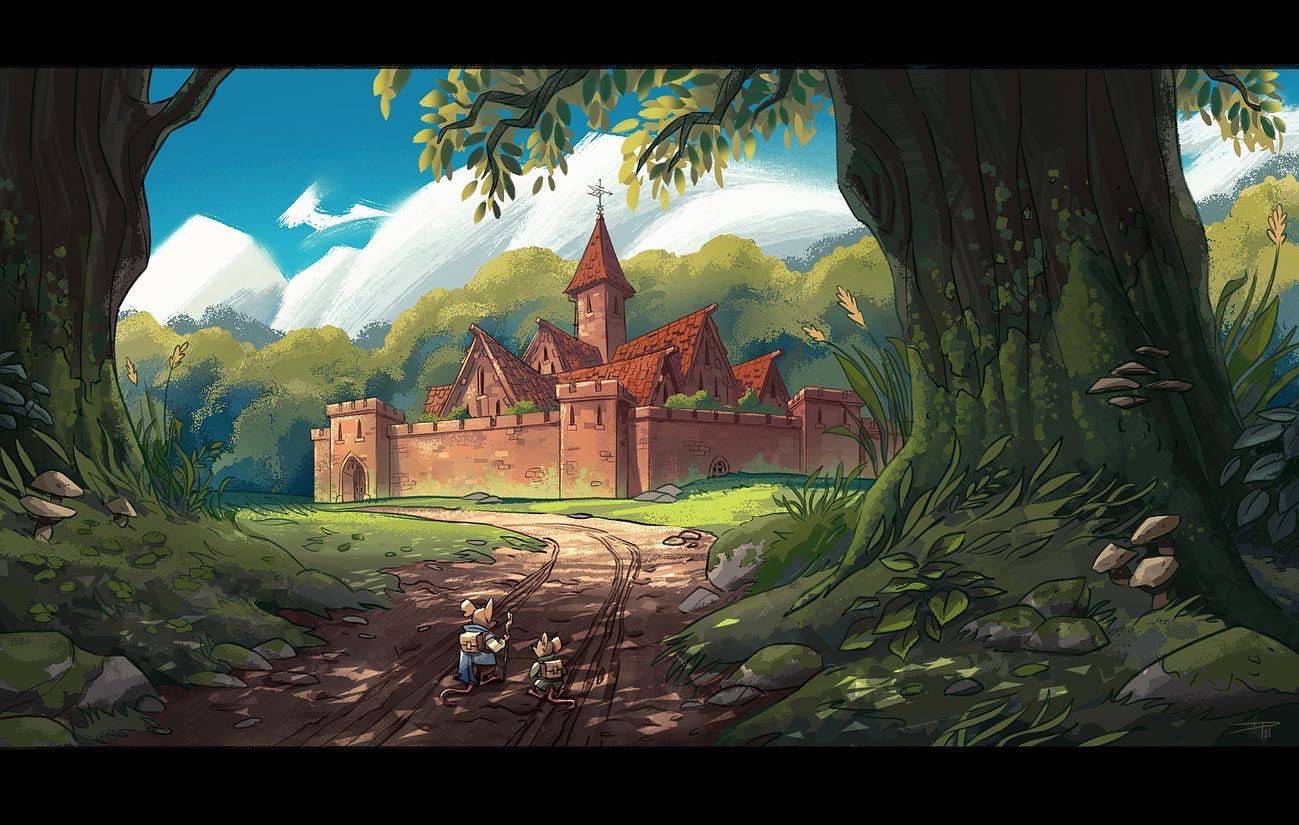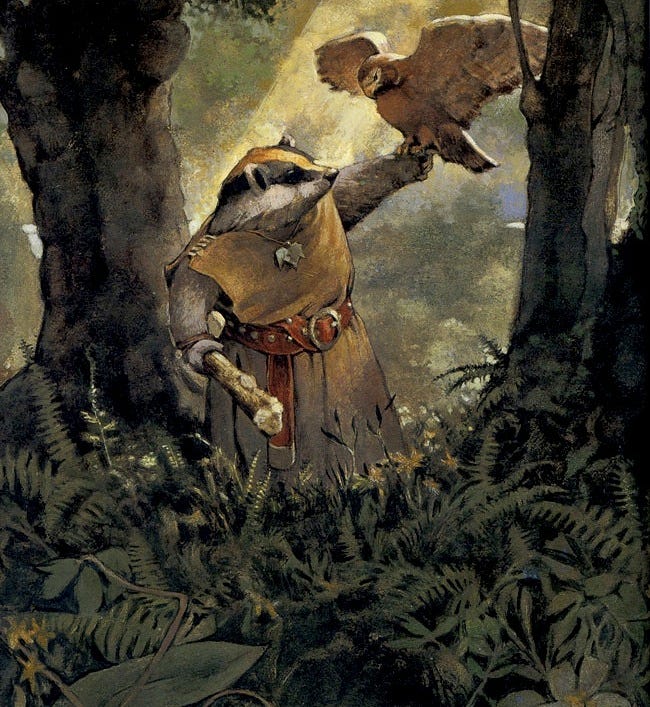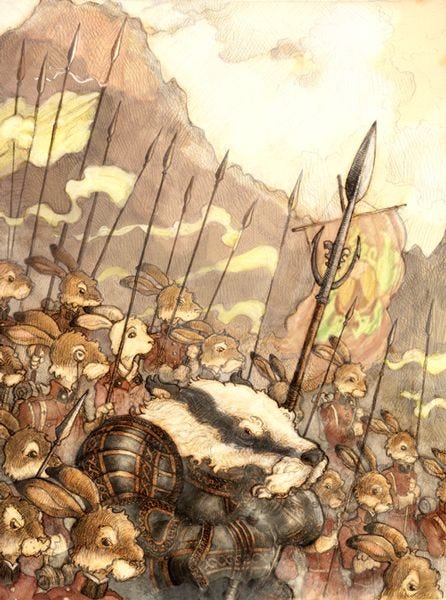As a child, I read the Narnia series and the Wind in the Willows which gave me a love for tales of talking animals living similarly to humans, with similar cultural customs although heavily parsed through the lens of a simple beast. This is a fascinating medium to portray both animals and humans, and can greatly assist a young child as they grow into adulthood. When the beavers start bickering over winter troubles in Narnia, or when frog and toad find issue with their ethnic differences in the Willows, it becomes clear that this medium can teach a child simple morality through an introspective look at animals and how their lives are related to our own.
This medium is ultimately fantastical, but it sometimes gives a very strong sense of folkish parables, and I cannot think of a series which best invokes this beyond from Redwall. In the Redwall books, the world is cast between good-beasts and vermin: mice, moles, squirrels, badgers, eagles, and otters (among others) versus rats, ferrets, weasels, crows, and foxes (among others). There are a few religious references both to Christianity and to paganism within the world, but it is by no means religious or even political. As a rule, the author tried to make the series as simple as possible so that they were focused entirely around the battle of vermin and good-beasts.
The author has expressed a common modern view towards Nazis and Vikings in interviews, calling them raiding vermin, and I denounce this ignorant comparison. Most of my favorite fantasy authors are sadly fools when it comes to politics and history, but I think that can be forgiven. A quote from Brian Jacques, the author shows that, like many others of his time period, he was unaware of the evils of the American and British bombers who dished out greater ruin upon Germany long before the air raids on Britain began:
During my youth Liverpool was one of the great seaports of the world and Herr Hitler bombed us daily and nightly for a very long time, taking lives and causing huge destruction. It was a threat I keenly felt. So I guess I thought of my real world as a threatened community and the evil-doers were the Luftwaffe.
Reminds me of WW2 historian David Irving bemoaning that he couldn’t get Christmas presents due to the bombs, or Professor Tolkien whining about how he could not get ample paper for his writings. It’s likely that due to wartime propaganda, they were unaware that Germany was being bombed to smithereens long before Britain was bombed.
Brian Jacques was an Irish-born author who passed away in 2011, and his spirit is remembered by his children and grandchildren. I really enjoy his books and their audio versions (Brian and his own children voice many characters, and there is traditional music accompanying every book) and I will share some music from the audiobook series at the bottom. I will also write briefly about the Redwall Cookbook. I will mostly be covering the European religious and cultural elements which are found within the books.
If you are a parent and are looking for wholesome European-centric books which do not shy away from violence, then look no further, as Redwall supplies tons of this.
The world is set in an alternate Britain with a large population of animals who are living in the Iron Age. The main country covered in the series is Mossflower, and the main settlement in Mossflower is Redwall Abbey. The Abbey is ruled by an Abbot/Abbess as well as a resident Redwall Warrior and Badgermum. Redwall Abbey functions as an autarky, meaning that it is self-sufficient with an Abbey Pond and Orchard, with its own medicine, library, forge, kitchens, and store of arms. Not far from Redwall Abbey is St. Ninian’s Church, which is a ruined structure from the ancient past. A precursor to Redwall Abbey is Loamhedge, another ancient abbey for good-beasts. The good-beasts who live at Redwall Abbey live there based on the right of association: any of them can leave and any good-beast can join, but if they choose to live there then they must pull their own weight and follow the rules set down by the Abbots.
A commonly recurring tribe of good-beasts are the Guosim, or the Guerrilla Union of Shrews in Mossflower. These beasties remind me of the Welsh, as they are often described as being vaguely Celtic, and they are the best warriors of the wild riverways with their logboats. They are often called upon by the Abbeybeasts to defend Mossflower, and the Guosim always leap at this chance with gusto. They have a very clannish society ruled by a high chieftain known as the Log-a-log, and are incredibly noble in spirit.
A commonly recurring location is Salamandastron, the stronghold of Badger Lords and their fighting hares, otherwise known as the Long Patrol. The Badger Lords are often subjected to a berserking rage known as the “bloodwrath” which has strong parallels to the berserkers of Nordic and Germanic tribes. They are sometimes paired with “Taburas” who are wise healers akin to the ancient folkmothers. Deep within Salamandastron is a secret chamber where the oldest badgers are buried, and there are strong ties to the fairy and dwarfish motif of the “King within the Mountain” or a buried champion who arises every so often to save the land. Indeed, every time Salamandastron is without a Badger Lord, a goodly badger roaming the lands is plagued with spirit-dreams from the older Badger Lords demanding that the noble role be fulfilled so that the woodlands can be kept free of vermin. Another similarity to dwarves would be the amazing smithing skills of the Badger-Lords, who are often sought out by goodly warriors for the crafting of new weapons or armor.
The Long Patrol of Salamandastron has strong parallels to the fighting bands of young warriors or the Mannerbund, although the Long Patrol is very regimental and were clearly inspired from Brian Jacques brief time in the British Army. I have read many Youtube comments from old British veterans saying that the Long Patrol and their songs and mannerisms take them right back to their time in the army. Whenever the woodlands are in danger, the Long Patrol goes on long patrols and brings battle to vermin, even if they are terribly outnumbered. They have Sergeants, Captains, Field Marshals, and even Gallopers (scouts).
Far to the North are the Highlands, a cold home to beasts with claymores, kilts, bagpipes, and deep Scottish brogues. Although there is no book placed within the Highlands themselves, Highland characters make recurring appearances, and they are perhaps my favorite for obvious reasons.
Across the western seas are a series of islands inhabited by good-beasts of a Gaelic culture and vermin of the sea, generally treated as pirates although sometimes treated as vikings. These each have clear connections to known islands, such as Ireland (the Emerald Isle.), Iceland (the Lands of Ice and Snow), the Orkneys (Riftgard), and even the Azores (Sampetra). Far into the southlands the reader is introduced to Southsward, Castle Floret, and King Gale which are clear references to Wales and the plentiful Norman castles built there.
There is no clear religion espoused within Redwall. Every beast within Redwall Abbey is called “Brother” or “Sister” by their peers, showing that there is a strong Christian monkish mindset utilized in the construction of Redwall. However, there is no reference to God. Instead, whenever the Abbey is threatened, the spirit of their first Warrior (Martin the Warrior) visits some good-beast and calls upon them to defend the Abbey. This reminds me of King Arthur in some ways, and Finn McCool in other ways, mostly due to the Heroic Ideal which is clearly shown to be the primary spiritual intermediator between the Dead and the Living. The Hero is therefore the only real force which can be called upon by the good-beasts of Mossflower. Indeed just like King Arthur and Excalibur, Martin’s Sword is often utilized as a divine relic handed down to Redwall Warriors, protected and preserved especially for noble warriors who show true virtue.
Basically, the only clear religion within the series is pagan Hero Worship, and perhaps ancestral reverence as well. Coupled with this are clear signs of nature reverence, with phrases such as “thank the seasons” replacing “thank the gods”. There are references made by fighting hares that when a warrior dies they become a star and are remembered forever, similar to Valhalla or Tir na nOg. When a goodly character dies, there are prayers made to them with supplications made to fallen warriors, and there are even otters who make little wooden versions of their fallen friends and toss them into lakes, similar to the pagan practice of placing in bogs special idols.
There are references to the “Dark Forest” made by vermin and good-beasts alike. The good-beasts have a very pleasant outlook on this place, seeing it not as a dark place of fear, but a bright version of the woodlands they know and love. On the other hand, vermin have a deep fear of Dark Forest’s Hellgates and do not want to pass through them. There are threats made by some heroes saying that they will meet their enemies at Dark Forest’s Hellgates and slay them again, and this may insinuate that a “second death” can be experienced within Dark Forest, and that the battle for good and evil continues even in the afterlife.
The vermin also have clear cults usually centered around a shamanic fox or witchy vixen, and the vermin are very superstitious about this. One such cult even produced a bastard race of weasel-ferrets who are described almost in the same light as werewolves, and they are greatly feared and ugly. Another cult was based around a set of holy gems held by a raven with a snake for a crown. Sometimes truly villainous vermin such as snakes can hold an almost anti-divine aspect in the eyes of terrified woodlanders.
The racial war between vermin and good-beasts is not treated lightly, and well-known good characters can die at any moment due to their own mistakes, altruism, or craftiness of the villains. Brian Jacques does not shy away from such content, which is refreshing as most modern children’s books refuse to cover that material in a respectful and virtuous way. The vermin are rarely converted to the side of good, but it does happen once or twice, and there are plenty of good-beasts who slip and fall into evil or treachery.
Every single Redwall book has some form of riddle or puzzle for the good-beasts to solve, and this curious element may be the most novel of them all. I used to be rather annoyed with this element, but as I got older the more I realized why I was annoyed: I just wanted to read about the battles; I didn’t want to think about some difficult riddle!
Brian Jacques developed his distinctive writing style of beautiful tactile descriptions while reading to blind children. Throughout the series, there are long paragraphs describing the bountiful food and drinks eaten by the Abbey beasts. He even has a Redwall cookbook out for sale, and I must say that the dishes sound delightful. Sometimes while reading the books, I have to stop and eat cheese with roasted nuts, or an apple with honey, as I simply cannot read about such tasty sounding food without joining in some way. From the Amazon description of the book:
Ever read a Redwall novel and wonder exactly what Abbot’s Special Abbey Trifle is? Or how to make Shrimp ’N Hotroot Soup, that delicacy of otters everywhere? Or Mole’s Favourite Turnip and Tater Deeper ’N Ever Pie? From the simple refreshment of Summer Strawberry Fizz to Great Hall Gooseberry Fool, they’re all here, along with dozens of other favorites sure to turn young hands into seasoned chefs.
As for the musical component to Redwall, Brian always has his characters playing songs and enjoying merriment, and I will link to an account that has all of the songs found in the books for your listening pleasure:
I know that this report is slightly different than my other reports in terms of content, but I hope it will be well-received nonetheless. We have much to learn from children, and when we can teach them to love animals, nature, cooking, virtue, and honor then we are accomplishing a great deed for the future. I think Redwall can help children better understand the struggle between good and evil, life and death, and honor versus dishonor.
Good-end.








TV series wat you think?
Seems wholesome to me and my kids enjoy it, esp the music. Judging by your description of these books TV version is simplified, with less emphasis on world building, but heroism and death in war are treated similarly.